Humming Blog |
|
Match the Patch
I sat in the deep grass along side the slow moving current and watched the Cutthroat Trout occasionally rise from the clear depths of the stream and gracefully sip flies off the surface of the water. I searched across the glass like surface to spot what the trout might be selecting as their primary food for that day. "Matching the Hatch" is the common term fly fishermen use to fooling the trout into thinking they are taking the real insect instead of the deceptive form you're throwing them. I chose the closest thing I could find in my fly box and gently tossed it upstream of the rising trout. As the fly slowly drift downward toward him, he started to levitate to the surface. He got within 6 inches and quickly rejected the fly. From a distance the trout believed it to be the real thing, but as he neared it, the differences turned him off. Repeatedly I would get one rejection after another. So I sat back in the grass, pulled out my portable tying kit and began to manufacture something that looked like the real thing. I tied up 3 flies in hopes they would get me through the day. My first attempt coaxed a trout without hesitation. It broke the surface with an aggressive take, and I soon had a beautiful Cutthroat trout to shore. I admired the beautiful colours and gently released it back into the stream. I continued on to land 5 more trout out of the same pool. This time I matched the hatch perfectly. I believe the same principles apply to every living thing on this planet. Everything has its season, and when a certain insect starts to hatch, it will hatch in abundance. When a particular flower starts to bloom it will bloom in abundance. This is the way it was all created. As these patterns of life develop, a reliant host becomes aware of its abundance, and starts to feed heavily on it, until that season ends and another begins. For those of us who understand the value of a hummingbird feeder, many of us have tried to get the young birds to solve the feeders early on. We know that when they figure out the never ending source of nectar within a feeder, we pretty much have a hummingbird for life. The problem is, when you stick a hummingbird feeder in amongst your flowers, they oftentimes overlook it, even though it's obvious to us. Hummingbird feeders rarely look like the real thing. Hummingbirds get so focused on the one type of flower, colour, and shape that they like, that the feeder almost becomes an obstacle for them to go around. I am absolutely convinced that if we can fool the hummingbirds into thinking our feeders are the same as the flowers, we'll have a much quicker conversion. This means creating a replica of the favourite flowers within your garden and replacing the ones on a couple of your feeders. This has been my project for the last few years, and as I slowly improve my conversion rate, I continue to work on my training feeders. Because Nasturtiums are one of the favourites in my garden, that's the one I've now replicated. Unfortunately I have to wait until July to test them out. I've had such a large number of people tell me that the hummingbirds don't like their feeders, but only their flowers. That's not true though. They just don't know the feeders yet. I'd encourage anyone out there who struggles with converting the young to feeders to try the same thing. Create a few flowers to look just like the favourites in your garden, and replace them on your feeder. Then place that feeder in the patch of similar flowers. The closer look we can create the more likely we'll keep hummingbirds around our gardens. This is what I call "Matching the Patch". I'd only do this with a few feeders, and as they associate your new flowers with the bottle they're attached to, they will eventually start noticing those bottles with other flowers, and the conversion will be complete.
0 Comments
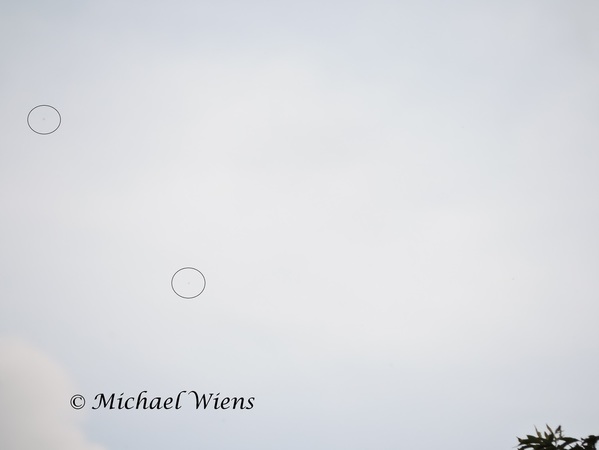 There are so many questions that are unanswered when it comes to hummingbirds, but the real fascination for me is how young hummingbirds instinctively know which direction to head for winter and why they even go into first place. Of course, we understand why they go south, but we're talking about a bird that has a brain the size of the peppercorn. We all know that they're spectacularly made, but do we really know the end of their abilities. Every year I witness young birds dancing around my garden and appear to be just randomly feeding without any direction. But when it's their time to go south, their territory expands from a small garden to thousands of square miles of unknown territory. This picture appears to be blank, but the circles indicate two young Ruby-throated hummingbirds during migration. You may have to look at the images in full screen. I don't know if these were two of my locals or migrants from hundreds of miles north of me. All I know is that 1 minute one was feeding at one of my feeders and the other was at a distant feeder. When decided, one of the siblings lifted up into the air and gradually disappeared into the sky. The other followed shortly after. I'm absolutely certain that they have a communication system between them, but without apparently seeing the first one leave, the second one lifted off and eventually caught up with its sibling. This is something I've witnessed repeatedly, and if I was to wage a guess, I'd say the younger sibling was still somewhat dependent on the older one. Ruby-throats typically migrate on their own, but in the case of two relatively young siblings, it's quite common for one to follow the other and eventually get separated during the southern migration. 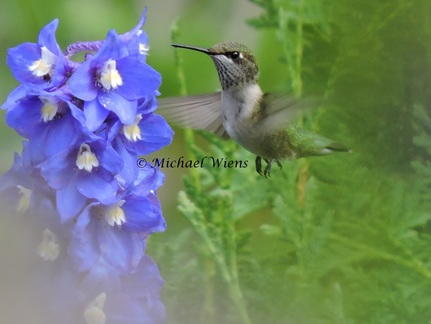 I sat motionless as the young hummingbirds fluttered around me, excited about the Delphiniums. This photo was taken through the leaves and branches while this young male sampled all of the goodness in our garden. As long as I sat completely still, the juveniles would sit on branches literally inches away. This led me to questions that many people have asked over the last few years. These are the questions all condensed into one: I just saw a hummingbird and I scared it away from my window, flowers, and feeders. Will it return? This may seem like a ridiculous question, but in fact it's a very good one that requires a bit of explanation, especially for those who are new to the hobby of hummingbirding. Many newbies immediately feel they've scared the hummingbird away permanently, and in some locations where hummingbirds aren't very common, some people go into panic mode. Here are my observations, and I believe these to be very accurate, as I've seen countless hummingbirds in every situation possible. First you have to understand that there are major differences between the juveniles and the adults. With the Northern migrant hummingbirds, when you first see them in Spring, they'll all be adults from the age of six months to approximately 10 years. The Males are looking for territory, and the females following days after will be spotted by those males. Females can be incredibly cautious, and for very good reason. They'll not only be looking out for themself, but for the young in the near future. The Males can be very curious but not foolish. If an adult male is new to a territory, it'll be far more cautious, and far easier to scare away in its first arrival. Once it's checked out surrounding territory and returned a few times to your feeder, nothing will keep it away. Both adults familiar with your feeders and garden will pick the most opportune time to feed. A male that's been around your garden in past years will show up and act as though it's never left. It felt secure in the past, and security is one key component of Males returning. The adult females, being far more cautious, can spook easily, but also return to their common place if they've been there before. If it's a newly arriving male or female, and you startle it, the male is a bit more likely to return than a female. New birds to a territory are always more cautious because they know the territorial ways of their own kind. This is why a new bird approaches a feeder with extreme caution. This brings me to another question. Should I avoid yard work or mowing the lawn with hummingbirds around? Here's the simplest answer. When you're expecting new birds to show up in your garden, whether in Spring or when the young first start leaving the nest, avoid anything involving noise and frequent movement. I've driven within 6 feet of one of my regular Males, with the lawn tractor, without scaring him from the feeder, and let me tell you it's not a quiet one. It's virtually impossible to get that near a female without her flying off. Young birds can be extremely naive and curious, but they're not typically used to lawnmowers and people in their natural nesting surroundings, therefore may fly off with movement and noise 50ft away or more. In their initial encounter with these unfamiliar noisy objects, you can scare young birds away permanently. However, once they become very familiar with your yard and feeders, they'll typically return repeatedly. In saying all this, this is how I would act in respect to these circumstances. In Spring when I anticipate their return, I mow the lawn and complete all the necessary yard work before they arrive. And for the next 2 to 3 weeks, all of these activities are halted. This means you have to know when the hummingbirds will arrive in your garden, and once you do this for several years you'll be able to narrow down the arrival time to one or two days. Later in the season, when the young birds are about to leave the nest, the yard work is halted again. Ultimately all of this is done to prevent all new birds to my garden from being scared away before they've learned just how great it's been prepared, just for them. 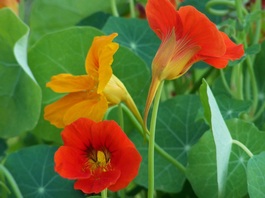 TOP 10 HUMMINGBIRD FLOWERS This is a blog I've thought about for a while now. Flowers are one of the most important aspects of a hummingbird garden. When hummingbirds see colour, they see food. This is extremely important when the young first leave the nest. They don't know feeders yet, but they are instinctively drawn to flowers. They will go to just about any flower once, but they will quickly decide which is worth the return. If we can figure out their favourites, it'll almost guarantee their return. Although some of the choices I've listed are not great for all climates, they will be for most. Please participate with your comments below to help others in all regions of the continent. Just include your favourite hummingbird flower and the Province or State. Vining Nasturtiums are one of my favourite annuals. They grow in various colors, most commonly reds, oranges and yellows. They grow very quickly and produce an abundance of nectar in each flower. The vining variety are preferred because you can grow them to lengths of well over 6 feet. The higher off the ground the more likely hummingbird will feed from them. These are a must have annual in anyone's garden, for attracting the young hummingbirds. The adult hummingbirds don't choose these as much because of the distance they have to insert their head to reach the nectar. Adult male and female hummingbirds are far more cautious about feeding from flowers if they're unable to see their surroundings. Zinnias are a very basic annual flower that are easy to feed from. They come in the widest range of colors and grow to heights of 24 inches or more. This is one of my favourite choices for young hummingbirds. This type of flower requires very little experience from hummingbirds to gather nectar. They simply see the large target and insert their long bill into the pollen. Million Bells produce an abundance of flowers more so than many other annuals. These beautiful jewel color tones are what make these flowers so attractive to hummingbirds. They flower profusely from Spring through Autumn, and are relatively hardy. As a matter of fact I currently have some still flowering after temperatures have reached below -7° C. With their masses of flowers, they produce one of the largest hummingbird targets visible from long distances away. Scarlet Runners can be an exceptional annual flower. Sometimes they are a hit or miss. Once a young hummingbird feeds from these flowers they can return over an over repeatedly, but if they can't solve the opening to these flowers they may not return. It is an exceptional choice for climbing, reaching heights in excess of 10 feet. Delphiniums are a hardy perennial good to zone 2 and colder. This is the one flower that draws the most attention from hummingbirds repeatedly, year after year, especially in regions further north. They typically produce flowers in colors between blue and purple, and sometimes in pinks and whites. They don't hold the quantity of nectar that many other flowers have, but there are enough flowers and nectar in each to make this perennial a top choice. If it weren't for the annoying worms that can take over these plants if not maintained, it would be the perfect perennial. Honeysuckle is a perennial good to zone 3. It may grow in harsher climates but doesn't produce as well. This is one plant that would be an absolute must in my garden if the hardiness would allow. Each flower produces an abundance of nectar equivalent to about two or three drops of rich hummingbird food. There are several varieties with different hardiness and color choices, but they are typically in the yellow, orange and pink tones. In zones 3 and warmer, DO NOT pass up on this choice. Hostas are a hardy perennial to zone 2. They produce a stock of flowers that hang downward, forcing hummingbirds to feed up into the flower. There are miniature varieties that wouldn't be as effective for hummingbirds, but the medium and larger varieties are a great choice. They produce flowers typically in the white to light purple colors. Fuchsias or one of the top choices of annuals. Although they are a mild perennial, they are typically grown as an annual in zones 9 and colder. There are many varieties, all of which are hummingbird favourites. The reds, purples and pink colours also fall within the ideal colours for hummingbirds. Crocosmia grow from Corms, which are very similar to bulbs. They are hardy to about zone 5 or 6. This last summer was my first successful year in getting these plants to flower. However, I live in a much cooler zone. The corms have to be planted out in Spring after all frost has left the ground in zones colder than 5. For those fortunate enough to leave them in the ground year round, this is a top choice for hummingbirds. They produce flowers in red, orange, and yellow, and each contains sweet rich nectar. Foxgloves are a Biennial. This means they require 2 years to complete their process. The first year they grow large leaves and develop enough energy so that they can flower the following year. They are hardy to about zone 3, but sometimes people have been able to grow them in zone 2, if in the right location. They can reach heights up to 6 feet or more, which also make this flower an ideal choice, along with the wide range of colours they produce. I've had many people ask me whether flowers are necessary for hummingbirds, or should they use strictly feeders? If I was restricted to only one of the two, it would be feeders. Fortunately, we've got the freedom to put out as many flowers and feeders as we like. In saying this, I would never limit myself to one or the other. They both have incredible value.
The reason feeders are of such great value is that the adult birds recognize them as a sure source of unlimited nectar. They aren't limited to one season or a limited amount of time like perennials are. Whether good weather or bad, early in the season or late, feeders provide a guaranteed source of food throughout the year. Hummingbirds always know that whatever their circumstance, they can always return to that exact same location knowing that it won't run out. Of course, this means we have to be very responsible in changing the nectar regularly with a proper cleaning. Flowers are important because they also provide a valuable source of food. They rely on flowers in regions where feeders aren't available, and without them hummingbirds may have to fly very long distances before they can find another feeder. Hummingbirds will never do without flowers. Even while they prefer to sit on that never ending source of nectar in a feeder, it's built within their DNA to desire the sweet nectar within flowers. As a matter of fact, when the young birds first leave the nest, flowers become their top priority. They bypass feeders because they don't look like the natural sources of food created. This is where flowers are of such great importance to any hummingbirder. We have to attract and keep them around our yard until they solve the feeders. This young hummingbird was eager to sample every flower available to it. It stuffed its head deep within the Nasturtium flower while the ant waited its turn. The other reason I love flowers in the yard is because they are what give us the greatest photo opportunities possible. Feeders can provide many photos, but to capture them feeding in the flowers just simply makes you one with nature. Juvenile Ruby-throated Hummingbird. August, 2016. 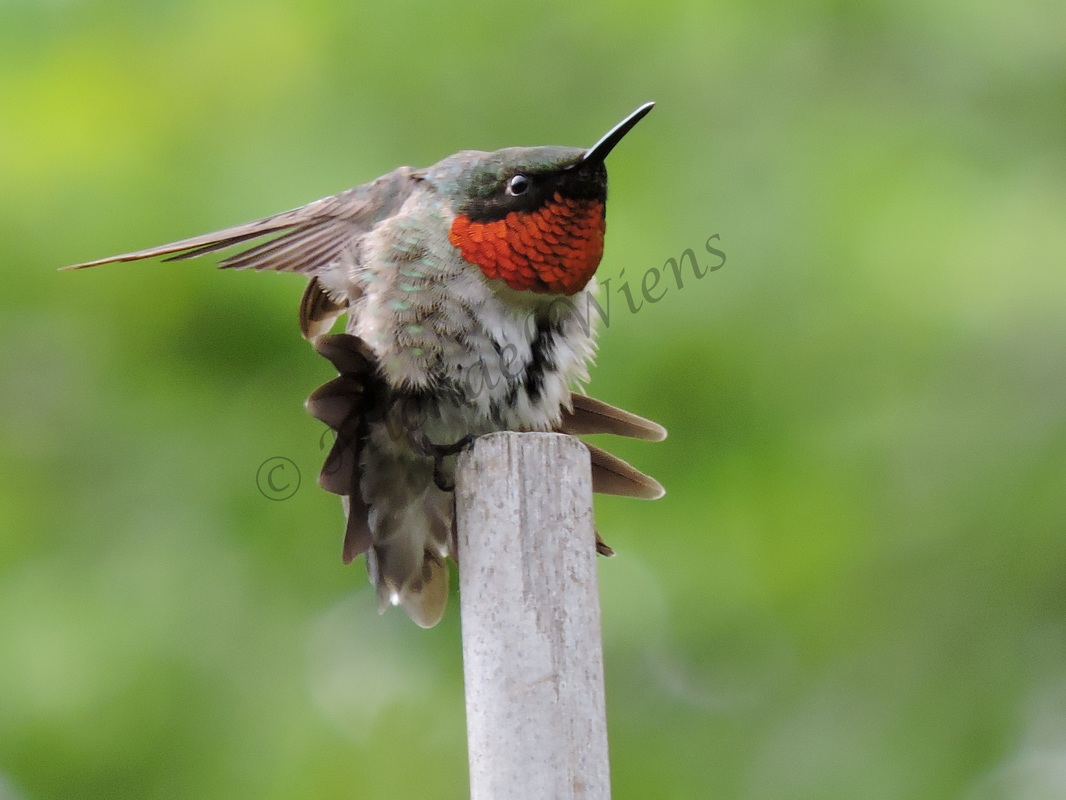 After having one of the coldest Octobers, November is starting to appear like Spring. I don't think any of us have the slightest clue about what's to come, including the birds. Currently we've been experiencing temperatures in the high teens, Celcius(or mid 60's F). As raindrops currently run down my windows, my curiosity leads me to the whereabouts of my hummingbirds. Typically around this time of year most of the Ruby Throated hummingbirds have left the United States, and once again that's the case. A few stragglers are still wondering about the eastern half of the U.S. while the western half of U.S.and S.W. Canada, as always, have the luxury of year round hummingbirds. Last year we had the most rare of sightings, with a Costa's hummingbird hanging around the Edmonton area in some of the most brutal temperatures you can imagine. This year things appeared quite normal late in the season with the birds. Although October came in with winter, I'm being extremely optimistic in hoping that winter has finished while we experience record temperatures here in Alberta. In only four short months the Canada geese will start appearing in my neck of the woods, while just a few days ago there were literally thousands of geese spread all over central Alberta, with no sign of leaving. While the Americas were the only continents blessed with hummingbirds, it's one that every birder of these continents couldn't do without. And now I'm counting the days, planning new ideas, and wishing the snow away until their return. Here's my Ziggy. He gave me several different poses last Spring, while I soaked up the images. He's a charming little guy, but even puts the fear in me with some of his different looks. He knew me well enough to stick close by, but never forgot the purpose at hand. This was a springtime shot where he displayed his full mating plumage. It's the time of year when all birds have the most beautiful colours for the purpose of attracting a mate. Every glistening olive body feather, and every radiantly glowing gorget feather is at its peak condition for attracting the light to enable them to put on a show and gain the attention of every curious female. I'm so hopeful of his return in Spring, but if not, I'm sure one of his many offspring will be willing to take over the reins. Adult Male Ruby Throated Hummingbird (Named Ziggy), May of 2016 in the Edmonton region of Alberta. Tip: To attract these beautiful birds in Spring, hummingbird feeders are an absolute must. They provide the greatest amount of food, without having them expend the energy to gain it. 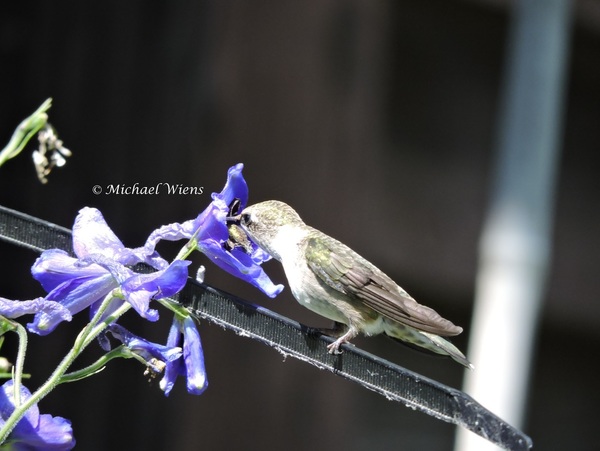 Q: How do you keep hummingbirds from leaving your yard? A: With Zip ties. Here's my overview of the 2016 hummingbirds season. We started off with a very unusual Spring. It was very mild in Western Canada and very cool in the East. I fully anticipated early hummingbirds this Spring, and that theory became 50% true. The Rufous hummingbirds came up the West Coast, and nothing slow them down heading into BC and Alberta. Many of them showed up at least three weeks earlier than... average times. The Ruby-throats always come up the eastern half of the United States, and this Spring they hit a cold wall just before they reached Canada. Although many of the Ruby-throats arrived at early average times, the rest of the northern migration was severely broken. Inconsistent arrivals randomly showed up all the way through mid July. Seeing this broken Northern migration made me question what kind of turnout we'd have in our garden just before the southern migration. Well, it turned out like nothing I've seen. The first young showed up right on average. We also had some very late females that showed up later than average, which meant later young from the nest. What made this season very unusual is that very few of the young stuck around beyond a few days. Many still figured out the feeders but were still called south before they matured. So what happened in our yard is that females would bring their young, they would feed for a few days, and then head south. This happened repeatedly throughout the time that they typically gather and squabble over flowers and feeders through the busiest time of the migration. The numbers usually increase and the majority stick around to create chaos before we slowly lose a few each day to the migration. There was never chaos in our yard this year, but I do believe we had similar numbers to last year. They all just didn't stick around to argue who gets what. Another thing that was very unusual this year was the early growth of perennials. They started early and ended early. Whether this had anything to do with them starting to leave early is merely speculation. I believe there are many variables that dictate their departure, many of which are beyond our knowledge. What I do believe is that the wider the migration is spread apart, the less likely bad weather is able to decimate their population. We've still had a few sightings in Alberta over the last few days, and this is probably an indication that NO severe, prolonged weather is imminent for the near future. Let me know if your season has been similar. 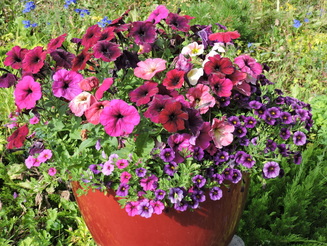 This is the perfect time of year for seed collecting, for those who start plants indoors. I want to specifically refer to Million Bells for planting indoors, even though I start just about every type of plant I have from seed. Very little information is out there about Million Bells and how to grow from seed. They haven't been sold anywhere until the last year or two because of certain patents. Many think you can't do it, and many haven't tried because of the lack of information. Last year I collected seeds from every colour of Million Bells that grew in our yard. Some produced an abundance of seed pods and some produced few to none. This made the value of these seeds worth a lot to me. So I collected as many as I could and kept them all separate. I planted each colour in a different tray and waited patiently through the spring to see what I'd end up with. These are my results: about 30% came true to type and the others produced different results. The ones that didn't come true to type still produced the most beautiful colours imaginable. I started them just a slight bit too late in winter so I didn't know what many of the colours would be when I planted them outdoors. This is the reason for many mixed colours in the same pot. The mix of colours didn't matter much to me as they all looked fantastic. What I did end up with this year was a lot of Million Bell seeds. I had an overabundance of seed pods growing on each plant, and now I have 20 years worth a million bell seeds for future years. Here are a few images of the results of three months worth of indoor planting to produce more Million Bells than you can possibly imagine. As long as you pick the seeds when they're fully ripe, then nearly 100% of them are viable. If you're wondering how you'll know if they're ripe for picking, take a close look at the pod. If you see slight black dots visible through the skin of the pod, then they are good. When you plant them indoors, allow for about 12 to 15 weeks for growing them indoors before transplanting outdoors. How does this all relate to hummingbirds? They really like them. I would rate them a 3 out of 5 for hummingbirds liking the flavour, and a 5 out of 5 as an attractor for bringing hummingbirds into your garden. |
Archives
June 2024
Categories
All
|
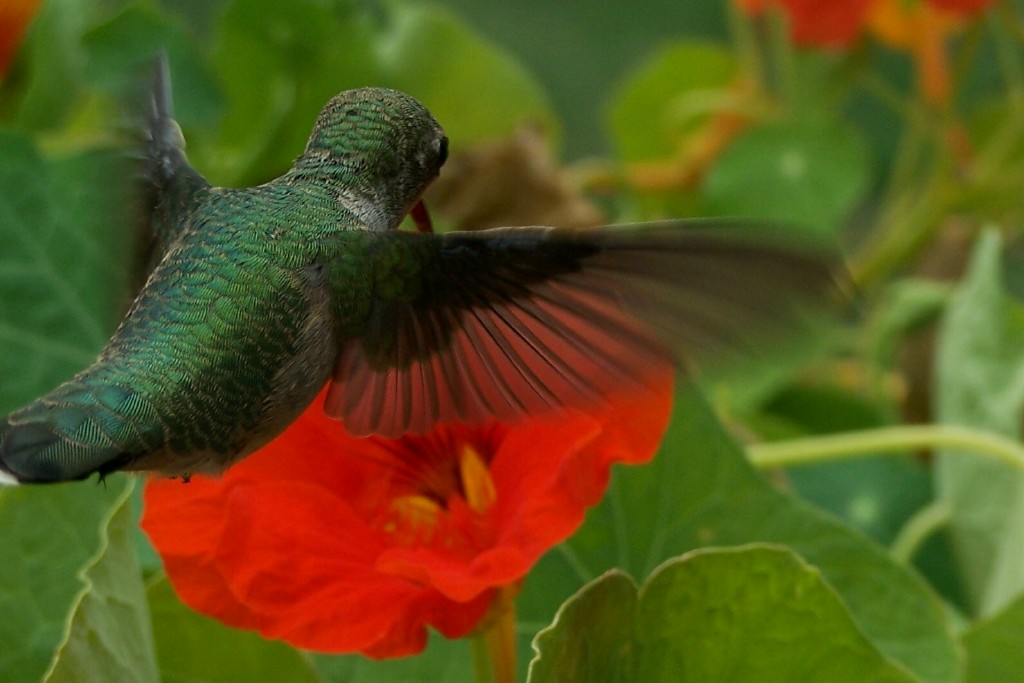
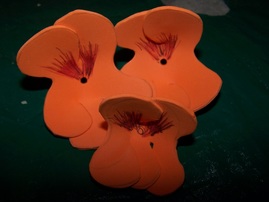
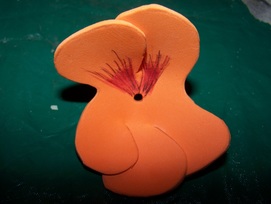
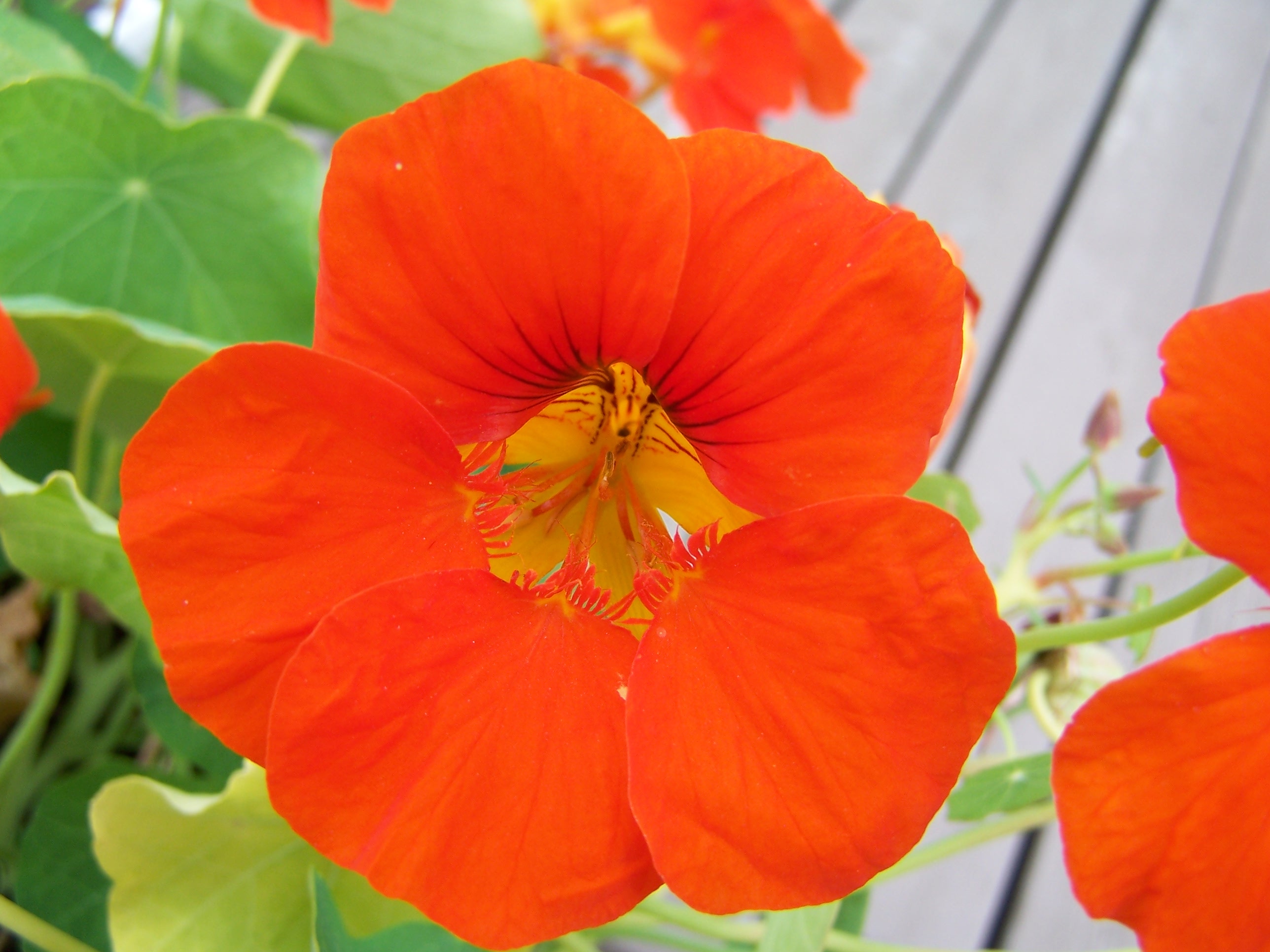
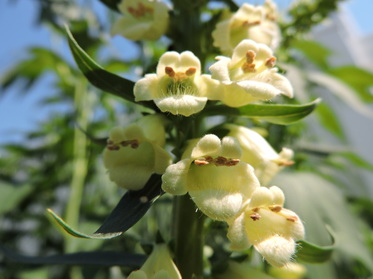
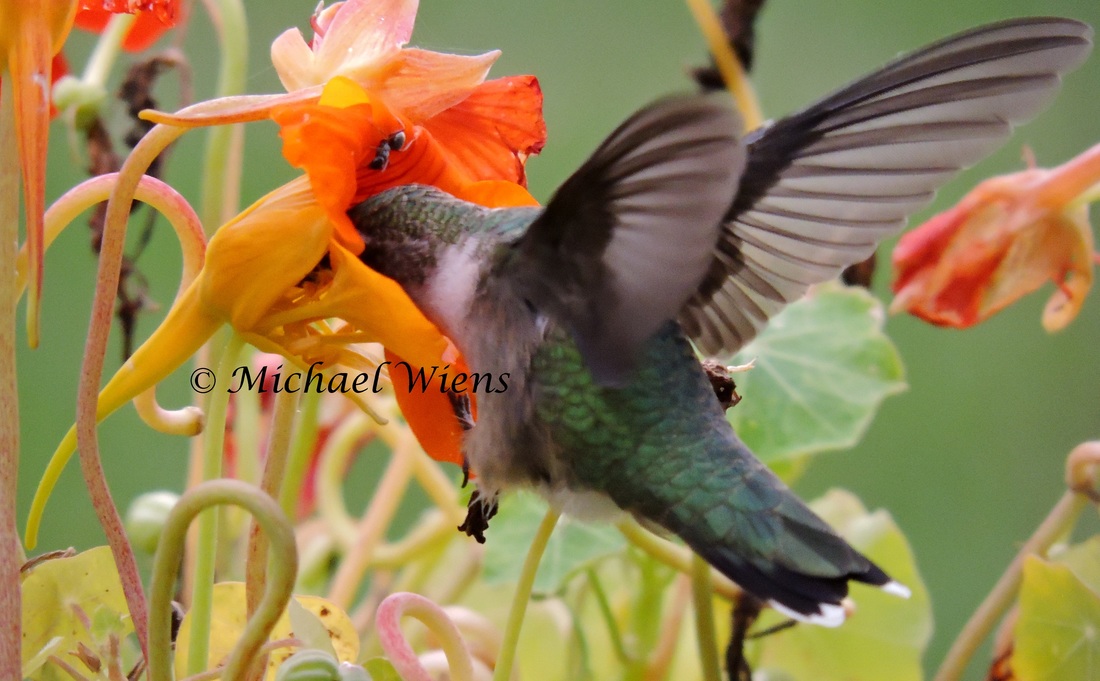
 RSS Feed
RSS Feed
